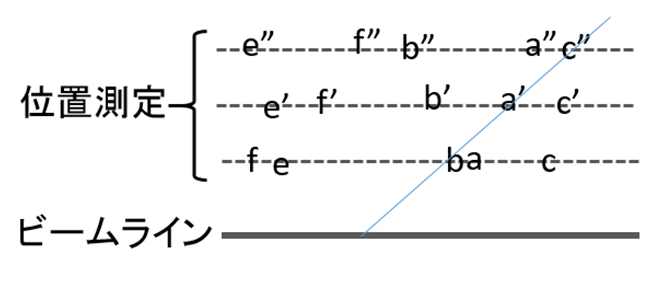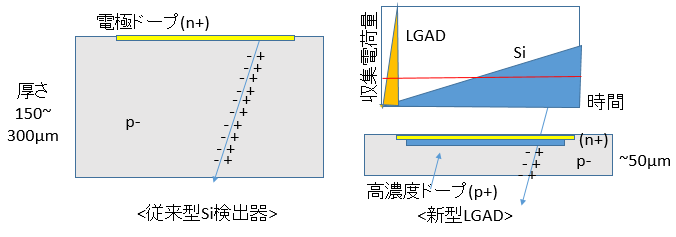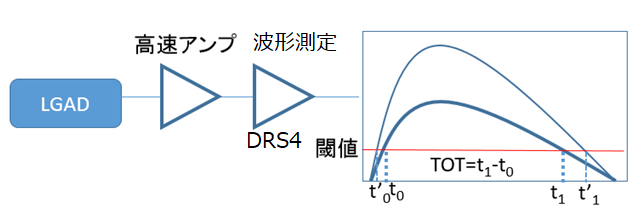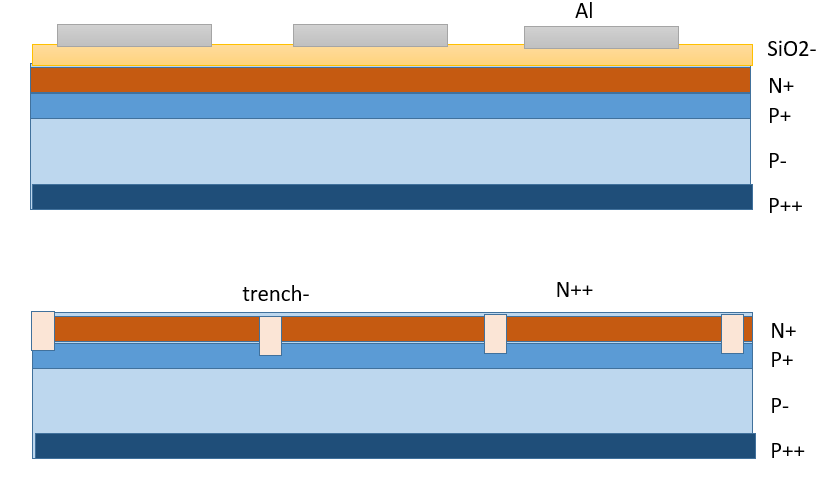Realisation of 4D tracker: KAKENHi(2019-2022)
Final Report (2023.5)
ABSTRACT
4-D semiconductor tracking devices which are capable of time measurement with precisions of 30ps and superior position measurement are to be developed using Low-Gain Avalanche Diode (LGAD) technology. For this purpose, finely segmented LGAD sensors in corporate with multi-channel readout electronics are fabricated and tested. In the future high-energy collider experiments, increased accelerator luminosity should make it very difficult to reconstruct the particle tracks in heavily overlapping events generated in each beam crossing if we rely only on the position information provided by highly segmented sensor. Addition of time information of 30 ps, which corresponds to 1 cm in space, will shorten the event reconstruction time by a method tracking the hits with proper time sequences and therefore recover the precision and its original capability of semiconductor trackers also in such an environment.
Fundamental question being addressed in this research
Measurements are most fundamental in every science. In particle physics experiments, precision measurements of the position and energy of the particles emerging from the interaction are of prime concern. High-spatial resolution devices fabricated using semiconductor technology have been deployed since 1980.
For precision measurements of Higgs properties and finding new physics beyond the Standard Model, the accelerator luminosity needs to be increased further. In such experiments, multiple interactions occur at one beam collision (the HL-LHC, for example, produces 200 interactions per beam crossing), and the enormous number of tracks are generated as backgrounds over one physically interesting collision. Combing hits among many such background hits to reconstruct the genuine event will become difficult and not realistic in view of CPU capability as well. Adding time information will be the break-through to solve this situation.
Scientific uniqueness and novelty
In the present CERN LHC experiment, beam bunches each consisting of about 1011 protons are collided every 25 ns producing 20-30 interactions per crossing. This number should increase further in the future experiments. At the LHC experiments, semiconductor devices with a spatial resolution of 5 μm are used to reconstruct the tracks and extrapolates them back to the interaction point to select only the tracks contributing to the interesting event, among the collision point spread of about 10 cm.

The above plot shows an ATLAS event composing of 17 interactions (tracks are extrapolated to the beamline while only the hits recorded in the inner-most layer are shown). A simplified interaction point distribution (for 10 interactions; this number will be 200 at HL-LHC and 1000 at FCC) is illustrated in the middle. In this event, interactions occurred at the beginning and end of the beam crossing are mixed, and there is a difference of 300 ps in a 10 cm wide spread. With a 4-D detector with O(30ps) resolution, the distribution should be measured as shown in the right where the time information separates the interaction points and it reduces the background interactions/tracks merged in the genuine interaction.

Connecting the hits (e.g. a->a'->a'') using time information will exclude false combinations (e.g. b->a'->c'') and hence reduce the event reconstruction time, creating an innovative event reconstruction philosophy.
The principle mechanism of the LGAD signal generation is explained below:

The (conventional) semiconductor sensors collect the carriers generated along the particle path traversing 150-300 μm thick bulk. The thickness is determined from the readout electronics noise and it takes at least 1 ns for charge collection. The LGAD, having a pn junction created by additional p+ layer, multiplies the signal by avalanche at this high junction field. As the signal is avalanche multiplied, thin LGAD sensors are possible and majority of the signal is created at the beneath of the junction, a superior time resolution of 30 ps has been demonstrated in our previous study (see S. Wada et al.)
This encourages us to investigate the possibility to separate the interactions occurring in the same event crossing.
What we have achieved so far
We have tested three LGAD diodes (2 mm square) lined in a 120-GeV proton beam, read out with single channel amplifiers and 5 GHz DRS4 based FADCs. As the signal rise time is improved with LGADs, the major contribution to the time resolution is the time walk (difference of t0 and t0').


As the FADC records the pulse shapes, we set the threshold to measure the time according to a pre-defined fraction f of the pulse height maximum. The time resolution was derived from the difference of the two sensors, as plotted above as a function of f.
A time resolution better than 30 ps is achieved at 8 degC environment.
Segmentation of LGAD
The first segmented strip-type LGAD turned to show large area of inactive area as shown below.

The plot shows the response across the 80-μm pitch strip measured by injecting collimated pulse laser of 1064 nm wavelength. The area when injected outside the multiplication layer is not responsible for charge multiplication. This data is implemented in a TCAD simulation, which is then used to design the segmented LGAD sensors with uniform response.

On candidate is the segmentation using trenches: physical trenches separate the readout channels while keeping the multiplication layers towards the vicinity of the trenches. Another is the AC-LGAD, where the multiplication layer and readout electrodes are AC coupled, therefore the readout segmentation can be designed irrespectively to the multiplication layer layout.
Conference presentations and Publicatons
Poster presentation at Vertex2019 by S. Wada
Vertex2019 Proceedings S. Wada, K. Onaru, K. Hara, Y. Unno, K. Nakamura
Poster presentation at HSTD12 by K. Onaru
HSTD12 Proceedings, K. Onaru, K. Hara, D. Harada, S. Wada, K. Nakamura, Y. Unno
HSTD11 Proceedings S. Wada, K. Ohnaru, K. Hara, J. Suzuki, Y. Unno, K. Nakamura, K. Hanagaki, Y. Ikegami, K. Yamamura, S. Kamada, Y. Abo, H. Tokutake, D. Yamamoto
Vertex2020 Proceedings K. Nakamura, S. Kita, T. Ueda, K. Hara, H. Suzuki
Optimization of capacitively coupled Low Gain Avalanche Diode (AC-LGAD) sensors for precise time and spatial resolution
NIM paper S Kita,. Nakamura, S. Kita, T. Ueda, I.Goya, K. Hara,
Vertex2022 Proceedings (submitted) S. Kita, K. Nakamura, T. Imamura, I. Goya, K. Hara
TREDI2023 presented by K. Hara, Mar 1st
2023 TYL-FJPPL proposal presented by K. Hara, May 11th






